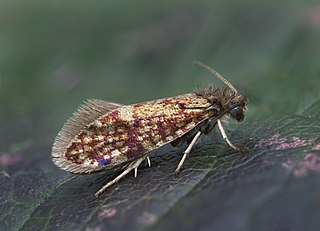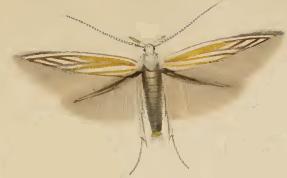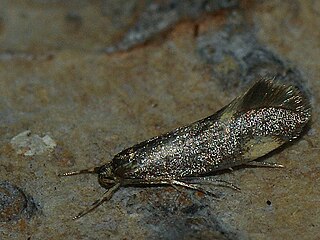
The Adelidae or fairy longhorn moths are a family of monotrysian moths in the lepidopteran infraorder Heteroneura. The family was first described by Charles Théophile Bruand d'Uzelle in 1851. Most species have at least partially metallic, patterned coloration and are diurnal, sometimes swarming around the tips of branches with an undulating flight. Others are crepuscular and have a drab coloration. Fairy longhorn moths have a wingspan of 4–28 millimeters, and males often have especially long antennae, 1–3 times as long as the forewing.

Eudonia mercurella is a species of moth of the family Crambidae. It is found in Europe, western China, Iran, Lebanon, Turkey, and north-western Africa.

Eudonia is a large and widespread genus in the grass moth family (Crambidae), subfamily Scopariinae. There is no common name for the roughly 250 species placed here; new species are still being described regularly. Although the genus was proposed early in the 19th century, many of these moths were for a long time retained in Scoparia, the type genus of the subfamily and a close relative of Eudonia. A few small genera have been proposed for separation from Eudonia, but given the size of this group this is not particularly convincing; thus, all are retained here pending a comprehensive phylogenetic review.

Eriocrania cicatricella is a moth of the family Eriocraniidae found in Europe. It was first described by Johan Wilhelm Zetterstedt in 1839. The larvae mine the leaves of birch.

Eriocrania unimaculella is a moth of the family Eriocraniidae found in Europe. It was first described by the Swedish naturalist Johan Wilhelm Zetterstedt in 1839. The larvae feed inside the leaves of birch, making a mine.

Mompha raschkiella is a species of micromoth in the family Momphidae. The moth was first described by German entomologist Philipp Christoph Zeller in 1838.

Elachista nobilella is a moth of the family Elachistidae found in Europe.

Ectoedemia argyropeza is a moth of the family Nepticulidae. It is a widespread species, with a Holarctic distribution.
Coleophora vibicigerella is a moth of the family Coleophoridae found in Asia, Europe and north Africa. It was first described by Philipp Christoph Zeller in 1839.

Coleophora currucipennella is a moth of the family Coleophoridae found in Europe. It was first described by Philipp Christoph Zeller in 1839.

Eudonia laetella is a species of moth in the family Crambidae described by Philipp Christoph Zeller in 1846. It is found in Fennoscandia, the Baltic region, Belarus, Russia, Poland, the Czech Republic, Slovakia, Hungary, Romania, Bosnia and Herzegovina, the Republic of Macedonia, Greece, Slovenia, Austria, Switzerland, Italy, Germany and Belgium.

Eudonia phaeoleuca is a species of nocturnal moth in the family Crambidae.

Metalampra cinnamomea is a moth of the family Oecophoridae. It was described by Philipp Christoph Zeller in 1839. It is found in most of Europe, except the Iberian Peninsula, most of the Balkan Peninsula, Ireland and Great Britain.

Helcystogramma lineolella is a moth of the family Gelechiidae. It was described by Philipp Christoph Zeller in 1839. It is found in most of Europe, except Ireland, Great Britain, the Benelux, the Iberian Peninsula, Italy and the Balkan Peninsula.











